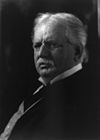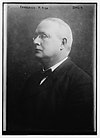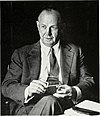|
AT&T Corporation
AT&T Corporation, an abbreviation for its former name, the American Telephone and Telegraph Company, was an American telecommunications company that provided voice, video, data, and Internet telecommunications and professional services to businesses, consumers, and government agencies. During the Bell System's long history, AT&T was at times the world's largest telephone company, the world's largest cable television operator, and a regulated monopoly. At its peak in the 1950s and 1960s, it employed one million people and its revenue ranged between US$3 billion in 1950[4] ($41.3 billion in present-day terms[5]) and $12 billion in 1966[6] ($117 billion in present-day terms[5]). In 2005, AT&T was acquired by "Baby Bell" and former subsidiary SBC Communications for more than $16 billion ($25 billion in present-day terms[5]). SBC then changed its name to AT&T Inc., with AT&T Corporation continuing to exist as a long distance subsidiary until it was merged into AT&T Enterprises, LLC on May 1, 2024.[7] HistoryOrigins  AT&T started with Bell Patent Association, a legal entity established in 1874 to protect the patent rights of Alexander Graham Bell after he invented the telephone system. Originally a verbal agreement, it was formalized in writing in 1875 as Bell Telephone Company.[8][9] In 1880 the management of American Bell created what would become AT&T Long Lines. The project was the first of its kind to create a nationwide long-distance network with a commercially viable cost-structure. The project was formally incorporated in New York as a separate company named American Telephone and Telegraph Company on March 3, 1885. Originating in New York City, its long-distance telephone network reached Chicago, Illinois, in 1892,[10] with its multitudes of local exchanges continuing to stretch further and further yearly, eventually creating a continent-wide telephone system. On December 30, 1899, the assets of American Bell were transferred into its subsidiary American Telephone and Telegraph Company (formerly AT&T Long Lines); this was because Massachusetts corporate laws were very restrictive, and limited capitalization to ten million dollars, forestalling American Bell's further growth. With this assets transfer at the very end of the 19th century, AT&T became the parent of both American Bell and the Bell System.[11] AT&T was involved mainly in the telephone business and, although it was a partner with RCA, was reluctant to see radio grow because such growth might diminish the demand for wired services. It established station WEAF in New York as what was termed a toll station. AT&T could provide no programming, but anyone who wished to broadcast a message could pay a "toll" to AT&T and then air the message publicly. The original studio was the size of a telephone booth. The idea, however, did not take hold, because people would pay to broadcast messages only if they were sure that someone was listening. As a result, WEAF began broadcasting entertainment material, drawing amateur talent found among its employees. Opposition to AT&T's expansion into radio and an agreement with the National Broadcasting Company to lease long-distance lines for their broadcasts resulted in the sale of the station and its developing network of affiliates to NBC.[12] On April 30, 1907, Theodore Newton Vail became President of AT&T.[13][14] Vail believed in the superiority of one phone system and AT&T adopted the slogan "One Policy, One System, Universal Service."[13][14] This would be the company's philosophy for the next 70 years.[14] Under Vail, AT&T began buying up many of the smaller telephone companies including Western Union telegraph.[13][14] These actions brought unwanted attention from antitrust regulators. Anxious to avoid action from government antitrust suits, AT&T and the federal government entered into an agreement known as the Kingsbury Commitment.[13][14] In the Kingsbury Commitment, AT&T and the government reached an agreement that allowed AT&T to continue operating as a telephone monopoly, subject to certain conditions, including divesting its interest in Western Union. While AT&T periodically faced scrutiny from regulators, this state of affairs continued until the company's breakup in 1984. Throughout most of the 20th century, AT&T held a semi-monopoly on phone service in the United States and Canada through a network of companies called the Bell System. At this time, the company was nicknamed Ma Bell. Undersea communications and operationsAT&T had a domestic and global presence in laying the infrastructure of undersea routes for telecommunications. In 1950, the U.S. Navy commissioned a network of undersea surveillance cables for foreign submarine detection. AT&T was probably, according to internal employees, involved in this Sound Surveillance System (SOSUS). After completion, AT&T began commercial operations in cable laying for communications in 1955.[15] The implementation of cables assured local and long-distance telephone or data services would provide revenue for the company.[16] AT&T Long Lines was one of the divisions responsible for the cable-laying and maintaining of Long Lines' undersea cables.[17] Western Electric was the manufacturing company responsible for production and supply of undersea coaxial equipment and later, fiber cables. Equipment such as repeaters was manufactured in Clark, New Jersey and coaxial cable was manufactured in Baltimore, Maryland .[18] Also, Bell Labs was responsible for the innovations of products[19] or technologies in cabling in transmission by undersea systems.[20] In 1955, the first trans-Atlantic telephone undersea cable, TAT-1, from North America to Europe was installed by AT&T. This installation allowed 48 telephone circuits to be used for long-distance calling.[21] When partnering with other global Telecommunications companies, such as the French Cables de Lyon and German Felten & Guilleaume, Bell Labs provided the specification and inspection of non Bell System cable for networks such as the TAT-2.[18] By the continuous undersea network installations, AT&T was a globally technology leader with the 1970 installed TAT-5 and the 1975 installed TAT-6, achieving 720 channels and then 4000 channels for transmitting voice or data.[18] Prior to 1963, AT&T had to charter oceanic ships, such as the CS Monarch (1945) for installations. AT&T purchased CS Long Lines in 1961 and operated it with several cable laying ships that would provide, either the laying or repair of cabling under the subsidiary, Transoceanic Cable Ship Company. After the break-up, AT&T operated their ships under a subsidiary called AT&T Submarine Systems Inc, based in Morristown, New Jersey, until they sold six ships to Tyco International Ltd in 1997 for $850 million.[22] AT&T continued to maintain their communication building facilities. Here is a list of the cable laying-ship fleet: 

Between 1951 and 2000, AT&T was listed 73 times in cable laying operations for specific routes deployed.[31] The Cable Ship Long Lines had 23 cable runs from 1963 to 1992, with the first deep-sea trial of optical fiber cable in 1982 leading to the consortium of countries and locations for the TAT-8 fiber cable implementation of 1988.[32] Break-up
 The United States Justice Department opened the case United States v. AT&T in 1974. This was prompted by suspicion that AT&T was using monopoly profits from its Western Electric subsidiary to subsidize the cost of its network, a violation of antitrust law.[33] A settlement to this case was finalized in 1982, leading to the division of the company on January 1, 1984, into seven Regional Bell Operating Companies, commonly known as Baby Bells. These companies were:
Post-breakup, the former parent company's main business was now AT&T Communications Inc., which focused on long-distance services, and with other non-RBOC activities. AT&T acquired NCR Corporation in 1991. AT&T announced in 1995 that it would split into three companies: a manufacturing/R&D company, a computer company, and a services company. NCR, Bell Labs and AT&T Technologies were to be spun off by 1997. In preparation for its spin-off, AT&T Technologies was renamed Lucent Technologies. Lucent was completely spun off from AT&T in 1996. Acquisition by SBCOn January 31, 2005, the "Baby Bell" company SBC Communications announced its plans to acquire "Ma Bell" AT&T Corp. for $16 billion. SBC announced in October 2005 that it would shed the "SBC" brand and take the more recognizable AT&T brand, along with the old AT&T's "T" NYSE ticker symbol. Merger approval concluded on November 18, 2005; SBC Communications began rebranding the following Monday, November 21 as "the new AT&T" and began trading under the "T" symbol on December 1. Present-day AT&T Inc. claims AT&T Corp.'s history as its own, but retains SBC's pre-2005 stock price history and corporate structure. As well, all SEC filings before 2005 are under SBC, not AT&T. The AT&T headquarters buildingsFrom 1885 to 1910, AT&T was headquartered at 125 Milk Street in Boston. With its expansion it moved to New York City, to a headquarters on 195 Broadway (close to what is now the World Trade Center site). The property originally belonged to Western Union, of which AT&T held a controlling interest until 1913 when AT&T divested its interest as part of the Kingsbury Commitment.[14] Construction of the current building began in 1912. Designed by William Welles Bosworth, who played a significant role in designing Kykuit, the Rockefeller mansion north of Tarrytown, New York, it was a modern steel structure clad top to bottom in a Greek-styled exterior, the three-story-high Ionic columns of Vermont granite forming eight registers over a Doric base.[34] The lobby of the AT&T Building was one of the most unusual ones of the era. Instead of a large double-high space, similar to the nearby Woolworth Building, Bosworth designed what is called a "hypostyle hall", with full-bodied Doric columns modeled on the Parthenon, marking out a grid. Bosworth was seeking to coordinate the classical tradition with the requirements of a modern building. Columns were not merely the decorative elements they had become in the hands of other architects but created all the illusion of being real supports. Bosworth also designed the campus of MIT as well as Theodore N. Vail's mansion in Morristown, New Jersey.   In 1978, AT&T commissioned a new building at 550 Madison Avenue. This new AT&T Building was designed by Philip Johnson and quickly became an icon of the new Postmodern architectural style. The building was completed in 1984, the very year of the divestiture of the Bell System. The building proved to be too large for the post-divestiture corporation and in 1993, AT&T leased the building to Sony, who then subsequently owned the building until it was sold in 2013.[35][36]  In 1969, AT&T began plans to construct an administration corporate complex in the suburbs. In early 1970, AT&T began purchases of land in the suburbs of New Jersey for this office complex and began construction in 1974. The award-winning architect, Vincent Kling, designed a Fordism[37] style, luxurious "Pagoda"[38] campus layout and the construction firms: New York–based Walter Kidde and Newark, New Jersey–based Frank Briscoe, managed this joint venture construction project with Vollers Construction of Branchburg, New Jersey, as the subcontractor. The 295 North Maple Avenue and Interstate 287 location of Basking Ridge in Bernards Township, New Jersey was completed in 1975 for the AT&T General Department offices. Employees began moving, in November 1975, to the seven inter-connected building complex using 28 acre of the property. The property had a 15-acre underground parking garage with spaces for 3,900 vehicles, and included a Class 1 licensed private helipad, a two-story cafeteria, a wood-burning fireplace, an indoor waterfall at the entrance lobby, and a seven-acre created lake for flood control. The entire property was 130 acre and cost $219 million to construct. Later, across the street from the complex, AT&T purchased additional land and established its Learning Center in 1985, at 300 North Maple Avenue, to become a 171 conference room inn. The AT&T Learning Center won the commercial property known as Somerset County's Land Development Award that year. In 1992, Basking Ridge location would become a corporate headquarters just before AT&T leased the New York City, 550 Madison Avenue building to Sony in 1993. The corporate statue, known as "Golden Boy" was moved in 1992, from the former New York City headquarters to this current New Jersey headquarters. In 1992, a corporate art consultant approached, artist sculptor, Elyn Zimmerman, to commission a 30-foot diameter project with fountain and seating area for the conference center courtyard gardens. In 1994, the project was completed and had one 34 ton granite boulder centered on top of the other boulders, which flowed water from the fountain designed by fountain engineer, Dr. Gerald Palevsky.[39] AT&T occupancy at the location peaked to 6,000 employees in its heyday before AT&T experienced competition and downsizing.  In October 2001, the Basking Ridge property was 140 acre with 2.6 million square feet and was placed for sale.[40] Basking Ridge employee occupancy, prior to the sale were approximately 3,200 employees. In April 2002, Pharmacia Corporation purchased the complex for $210 million for their corporate headquarters from existing Peapack-Gladstone, New Jersey headquarters.[41] A short time afterwards, in 2005, Verizon purchased the former complex, excluding the hotel/conference room building,[42] from Pfizer for Verizon Wireless Headquarters and consolidation of employees from Manhattan as well as other nearby New Jersey building locations.[43] In 2007, Pfizer placed the North Maple Inn for sale. At the time, it was a four-diamond, certified hotel and conference center under IACC ("International Association of Conference Centers") designation.[44] In 2015, Verizon performed a sale-leaseback agreement valued at $650.3 million on the complex with the address previously known as One Verizon Way.[45] In 2017, the 35 acre hotel/conference center was known as the Dolce Basking Ridge Hotel and sold for $30 million.[46] DissolutionOn February 15, 2024, AT&T Inc. filed notice with the Kentucky Public Service Commission that it intends to make an internal structural change and merge AT&T Corp. into AT&T Enterprises, Inc., which will become a limited liability company. In a filing with the South Dakota Secretary of State dated January 30, 2024, the reason given for the merger is that New York state law does not allow AT&T Corp. to be directly converted into an LLC.[47] Although acquired by SBC in 2005, AT&T Corp. has remained a separate entity within the corporate structure of AT&T Inc. The merger, said to create “greater operational efficiencies”, will end the existence of the nearly 140-year-old entity. The internal merger took effect on May 1, 2024.[48] DivisionsAT&T, prior to its merger with SBC Communications, had three core companies: AT&T Alascom sold service in Alaska. AT&T Communications was renamed AT&T Communications – East, Inc. and sold long-distance telephone service and operated as a CLEC outside of the borders of the Bell Operating Companies that AT&T owned. It has now been absorbed into AT&T Corp. and all but 4 of the original 22 subsidiaries that formed AT&T Communications continue to exist. AT&T Laboratories has been integrated into AT&T Labs, formerly named SBC Laboratories. Nicknames and brandingAT&T was also known as "Ma Bell" and affectionately called "Mother" by phone phreaks. During some strikes by its employees, picketers would wear T-shirts reading, "Ma Bell is a real mother." Before the break-up, there was greater consumer recognition of the "Bell System" name, in comparison to the name AT&T. This prompted the company to launch an advertising campaign after the break-up to increase its name recognition. Spinoffs like the Regional Bell Operating Companies or RBOCs were often called "Baby Bells". Ironically, "Ma Bell" was acquired by one of its "Baby Bells", SBC Communications, in 2005. The AT&T Globe Symbol,[49] the corporate logo designed by Saul Bass in 1983 and originally used by AT&T Information Systems, was created because part of the United States v. AT&T settlement required AT&T to relinquish all claims to the use of Bell System trademarks. It has been nicknamed the "Death Star" in reference to the Death Star space station in Star Wars which the logo resembles. In 1999 it was changed from the 12-line design to the 8-line design. Again in 2005 it was changed to the 3D transparent "marble" design created by Interbrand for use by the parent company AT&T Inc. This name was also given to the iconic Bell Labs facility in Holmdel, New Jersey, now a multi-tenant office facility.[citation needed] Notable buildings with the AT&T logo
List of AT&T chief executive officersThe following is a list of the 16 CEOs of AT&T Corporation, from its incorporation in 1885 until its purchase by SBC Communications in 2005.[50]
See also
ReferencesCitations
Sources
External links
|
|||||||||||||||||||||||||||||||||||||||||||||||||||||||||||||||||||||||||||||||||||||||||||||||||||||||||||||||||||||||||||||||||||||||||||||||||||||||||||||||||||||||||||||||||||||||||||||||||||||||||||||||||||||||||||||||||||||||||||||||||||||||||||||||||||||||||||||||||||||||||||||||||||||||||||||||||||||||||||||||||||||||||||||||||||||||||||||||||||||||||||||||||||||||||||||||||||||||||||||||||||||||||||||||||||||||||||||||||||||||||||||||||||||||||||||||||||||||||||||||||||||||||||||||||||||||||||||||||||||||||||||||||||||||||||||||||||||||||||||||||||||||||||||||||||||||||||||||||||||||||||||||||||||||||||||||||||||||||||||||||||||||||||||||||||||||||||||||||||||||||||||||||||||||||||||||||||||||||||||||||||||||||||||||||||||||||||||||||||||||||||||||||||||||||||||||||||||||||||||||||||||||||||||||||||||||||||||||||||||||||||||||||||||||||||||||||||||||







